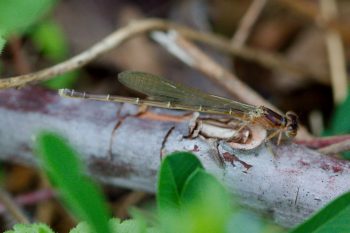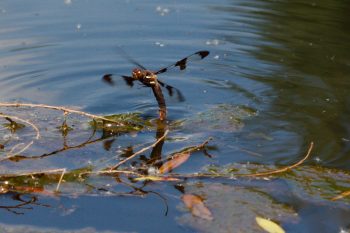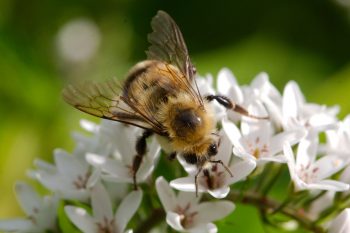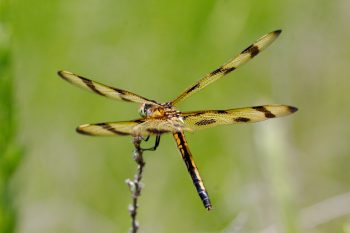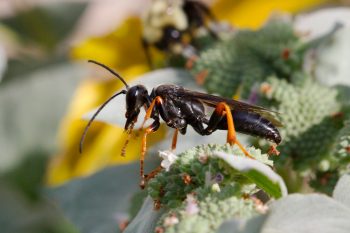I walked across Rt 28 today, wanting to be outdoors for a little while. On the slope leading down to a fairly large drainage pond there were little clumps of yellow flowers, most likely American wintercress (Barbarea orthoceras). I sat next to one such clump and took a handful of pictures. I thought about trying to get a photo of the swallows that were patrolling the pond and presumably helping keep the bug population under control. I didn’t really have the right equipment for that and it’s pretty tough, in any case, as they are really moving fast and are not very big. I settled for photographing this little damselfly instead.
Tagged With: Insecta
Rove Beetle
I wen out again today to see what I could see. The sky was overcast so the sun wasn’t so hot. The dragonflies were also not about in such great numbers. I did get a few pictures,though, including some of this beetle that I think is a rove beetle, Family Staphylinidae, the first or second largest animal family, with somewhere around 56,000 species in 3500 genera. Only the ichneumon wasps, family Ichneumonidae is larger, with an estimated 60,000 species. Anyway, there are some 4,400 species of rove beetle in our area. You’d think you’d see them a lot more often.
Ant
I took some pictures of flowers and plants in the back yard this evening. I had gotten down onto the ground to see if I could get a good picture of a syrphid fly on an allium flower. I got a few pictures but they weren’t as sharp as I would have liked. Then I noticed this ant on another allium and got a handful of pictures of it. They aren’t all that sharp, either, but will have to do, because I didn’t really get anything better. I’m pretty happy with the framing of this picture and the exposure, but the focus isn’t that great. In my defense, this little fellow was moving around quite a bit and the light was starting to wane a little.
Eastern Bumble Bee
I went out looking for pictures as usual this afternoon, when I got home from work. There is Campanula in bloom in the yard, and I took some pictures of those flowers. They don’t tend to come out the same color in photographs as they are in real life. Not entirely sure why. Then I moved over to the gooseneck loosestrife (Lysimachia clethroides), which is a real attraction to the bees. It’s quite invasive and I really would recommend against planting it in the strongest language, but if you already have it, you might as well enjoy the bees. There were a few honey bees but mostly it was the common eastern bumble bees (Bombus impatiens) that were moving quickly from flower to flower.
Firefly
This firefly, a beetle in family Lampyridae, probably in the genus Photinus, was on a weed in the back of our garden this evening. According to BugGuide.net there are 34 described species in this genus and identification of a single specimen by morphology alone is often impossible. So, I’m not even going to try. It’s a firefly and that’s good enough. One interesting fact about fireflies is that females in the genus Photuris are known to lure in males of Photinus species and eat them in order to obtain a defensive, steroid-like compound that they contain.
Halloween Pennant (Celithemis eponina)
I went out to the vacant lot next to my office today. It was quite warm but the weather patterns promise hotter weather ahead. I got a few pictures of an orbweaver spider (Leucauge venusta) but since I posted one of those recently, I’ve decided to go with this pennant, probably a calico pennant (Celithemis elisa). I also got one, not so good photo of a tailed blue, but I’m holding out for a better picture before I post one of those.
Note: I labeled this as a calico pennant (Celithemis elisa) without paying close attention to detail. I’m relabeling it as a Halloween pennant (Celithemis eponina).
Halloween Pennant (Celithemis eponina)
I know I’ve posted a picture of a similar dragonfly recently, but I didn’t get a lot of great pictures today so this is what I have. This is also, I think, a better picture than the one previously posted. I had originally labeled that one as a calico pennant (Celithemis elisa) but I’ve rethought that and have relabeled it as a Halloween pennant (Celithemis eponina), the same as this one. It’s a handsome dragonfly, whatever it is. I had tough time getting close enough for this picture, so I’m relatively pleased with it.
Acmaeodera pulchella
I went out to photograph flowers this evening but came across this metallic wood boring beetle (family Buprestidae) on a black-eyed Susan. There are twelve dozen species of Acmaeodera in our area and one of the experts at BugGuide.net identified it as Acmaeodera pulchella, sometimes known as the flat-headed bald cypress borer. We’re not really in bald cypress country but they feed on a pretty wide variety of trees, so that’s not really an issue.
Eristalis transversa (Transverse Flower Fly)
I was taking photos of the black-eyed Susan flowers this evening when I spotted this little fly, a transverse flower fly (Eristalis transversa) visiting them. It wouldn’t stay still for very long and I had a hard time getting a good picture. Ideally it would be on top of the dark eye in the flower, but I wasn’t able to get that. I like the combination of colors that matches the flowers. These are pretty little flies and easily spotted in the garden. As flies go, I enjoy these about as much as any.
Danaus plexippus (Monarch)
As I’ve mentioned, the eastern tiger swallowtail (Papilio glaucus) is the most plentiful, large butterfly in our yard all summer. They are followed by the monarch (Danaus plexippus) in a distant second place. They generally are harder to photograph than the swallowtails but this one let me get close and I’m pretty happy with the results. It’s perched on Verbena bonariensis growing in our front yard, near where the Colorado spruce used to be.
Junonia coenia (Common Buckeye)
I chased down some butterflies in the back yard today, including this common buckeye (Junonia coenia). They are resident year round in the south as far north as North Carolina and they move north over the course of the summer. Because of that we tend to have them later in the year than other butterflies and I’ve only just started to see them. They are pretty easy to identify and are very different to the other species that we have. This one, obviously was interested in the black-eyed Susan flowers that are in such abundance in our yard right now.
Atteva aurea (Ailanthus Webworm Moth)
I took some butterfly pictures this afternoon, as well as some flower pictures. While sitting in the chair that Cathy was in when I took the picture for a few days ago I could get pretty close to a few flowers without having to strain my back. Then walking around I saw this prettily colored ailanthus webworm moth (Atteva aurea) on a black-eyed Susan. It took me a while to get down on the ground to get the pictures but I think it was worth the effort. Although it’s named for and feeds on a non-native tree, the Ailanthus webworm moth is actually a North American native from Florida, where its original host was the Simarouba glauca (paradise tree) and Simarouba amara.
Caterpillar
I was a little worried about sitting through church this morning but my back tolerated sitting for long enough that it wasn’t a problem. We were happy to see some friends that visited the church a few weeks ago come back again today. After church we walked to the Stadtman Preserve next door to see what was going on there. They’ve been renovating the mid-century modern house that the Stadtmans build and lived in and it’s nice to see the progress. There were naked lady’s (Amaryllis belladonna) in bloom and I got a few photos of this little brown and white caterpillar. I have no idea what sort of creature it is. I’m going to guess a moth but I won’t go any farther than that.
Megachile mendica (Flat-tailed Leaf-cutter Bee)
I have yet another “insect on a black-eyed Susan” photo today. These are by far the most numerous flowers in our yard this time of year. They aren’t necessarily the insects’ favorite flower but most pollinators are fairly broad minded and visit lots of different plants. The Buddleia bushes are the clear favorites with the butterflies and the mountain mint (Pycnanthemum muticum) is probably the most popular with the bees and wasps, but they all visit the black-eyed Susans, as well.
Dolichovespula maculata (Bald-faced Hornet)
The pollinators are quite busy in the yard these days. Especially in the afternoon, when the sun is hammering down on the flowers, the bees, wasps, moths, and butterflies are to be seen in great numbers. The mountain mint (Pycnanthemum muticum) is literally a buzz with them. The skippers seem to favor the black-eyed Susans. The butterflies, not surprisingly, go for the butterfly bush (Buddleia). That being said, this large hornet was coming back again and again to the buddleia. I’m not as happy with it as I might be but it’s a decent photo. These wasps are social and build large paper enclosed nests. I’m a little surprised to only see one of them, but there are surely more around the area.
Skipper
I took a few wasp pictures again today but they were too blurry to use. One was clear enough to get a good idea what it was, but nothing to write home about. Then I went out to the middle of the back yard and took some photos of the berries on the American beautyberry (Callicarpa americana). They’re starting to turn pale purple and it’s easy to see where the shrub gets its common name. This skipper landed on the berries and I was able to get close enough for a pretty good portrait before it skipped away. I’ve only occasionally gone to the trouble to identify individual skipper species. With some notable exceptions they are all pretty similar and I just never get around to it.
Boloria bellona (Meadow Fritillary)
What an absolutely beautiful day it was today. The high was in the 70s and in August, that’s a rare and joyous thing. I worked on the car today, gluing the rear-view mirror back on in one van and replacing the struts that hold open the rear hatch on the other. Cathy and I also did a fair amount of yard work, pulling up weeds and beginning the process of clearing out some of the central bed in the back yard. There were two trees where that bed is, a medium sized red maple and a fairly large silver maple. They’ve been down since the spring of 2013 and as the roots have rotted, a few holes have opened up and need to be filled. The whole bed needs quite a bit of work, to be honest, including digging out some particularly tenacious weeds. I took a break to take pictures of some of the many butterflies that were out today, including this meadow fritillary (Boloria bellona), a pretty medium sized brush-footed butterfly.
Sphex nudus (Katydid Wasp)
The bees and wasps are out in force these days. I spent a little time around the mountain mint (Pycnanthemum muticum) this afternoon and enjoyed the variety of buzzing insects (most of them are basically silent, actually). The most numerous are the bumble bees (Bombus impatiens) and the large but gentle carpenter bees (Xylocopa virginica). The wasps are pretty well represented, though, and today I saw a handful of these katydid wasps (Sphex nudus) as well as some potter wasps (Eumenes fraternus). I got a few photos of that last one, but they weren’t as good as I would have liked. I’ll keep trying.
Tumbling Flower Beetle
I didn’t get any really good pictures today. It was after 6:00 when I went out and there wasn’t much insect activity this evening, for some reason. I did come across this little beetle, about 5mm long, on the petal of a black-eyed Susan. I think it’s a Tumbling Flower Beetle in Family Mordellidae (possibly in Genus Mordellistena, but I am really unsure). It’s a cute little thing and I was only able to get a few pictures before it flew off.

